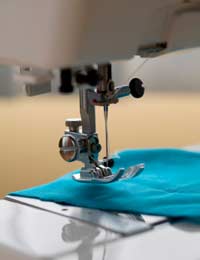How to Sew Stretchy Fabric

There are lots of different stretchy fabrics on the market today that are great for exercise wear, dance wear and generally cool looking clothes, but sewing with them can prove a lot more difficult than you might expect! In order to get good results it's important to know what you're doing from the start.
Sewing Machine Settings
Before you begin, it's important to get your sewing machine set up properly. The most important thing is to use the right sort of needle. A ballpoint needle will slide in between the fibres in your fabric rather than tearing them and causing it to fray. You can use any kind of thread, but a slender textured one, such as pure polyester or nylon, will decrease the risk of bunching. Polyester also has a bit of stretch which will help if you get into trouble with tight seams.Because the fabric and the stitches will move against each other when the garment is worn, it's best to use a long zigzag stitch. Alternatively you can use a triple stretch stitch if this is available on your machine. Every individual stretchy fabric has its own ideal stitch length, so experiment until you get it right. Relax the tension on the presser foot to make sure the fabric moves easily and stitches don't get bunched up.
Preparing the Fabric
Because clothes made from stretchy fabric will stretch out when put on, it's important to have enough give in the seams. To achieve this, you'll need to make sure the fabric is at least partially stretched out when you work with it. Use a ruler to measure the degree of stretch and keep it even across the whole piece of fabric.To keep the stretch consistent after measuring, you can pin the stretched fabric to tissue paper. Slide the pins in carefully so you don't tear the fibres. Some people prefer to use adhesive tape for this, but it can leave marks on the fabric, especially if you're using material with a shiny surface, and because it will need to grip quite tightly it can also distort the fabric as you peel it off. Tissue paper should come off without problems.
When you're developing your own designs using stretchy fabrics, think carefully about the placement of seams and how the wearer of the finished garment is likely to move, as well as about how they will take it on and off. Try to place seams so that they will experience minimal stress.
Finishing
Because of the way your stitching will behave when you relax your fabric after sewing, stretchy garments can sometimes be left with lumpy, bunched-looking seams. The easiest way to get rid of these is to gently steam the garment and press the seams. Only use your iron on the wrong side of the fabric, on a low heat, or iron the garment through a damp tea towel.Sewing stretchy fabric may seem difficult at first, but there is a knack to it, and once you get the hang of this you will soon find that you can turn out clothes the way you want.


Re: Selling Your Fashion Designs Online
Hi how can i sell my designs while being a student in the 10th grade
Re: Basic Equipment for Starting up a Fashion Business
I want to start small business as a student and also fashion designer, and I don't have much money for…
Re: Basic Equipment for Starting up a Fashion Business
I'm a fashion designer, I want to start a fashion school, I want to know the necessary requirements to…
Re: Basic Equipment for Starting up a Fashion Business
I am a fashion designer and I am working on having my own fashion brand,please what are the necessary…
Re: Basic Equipment for Starting up a Fashion Business
I am an up coming fashion designer,I want to start my personal clothing brand. Please what are the…
Re: Basic Equipment for Starting up a Fashion Business
What can 30,000 do for fashion designing business Why you need an additional tools
Re: Keeping Records of Your Patterns and Fabrics
Can anyone tell me the type of records to be kept as a garment maker?
Re: Selling Your Fashion Designs Online
Hi I'm not a professional designer, but I have doing many sketches of trending dresses. I'm wondering how can I sell them…
Re: Selling Your Fashion Designs Online
Hi there, I'm not a fashion designer too I just started my intermediate and I do have many designs of beautiful outfits I…
Re: Selling Your Fashion Designs Online
Hie, I'm a fashion designer, I need help pliz... I would like to make a sale of my sketches online.